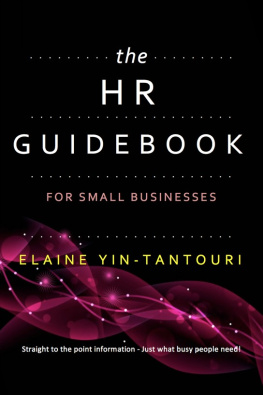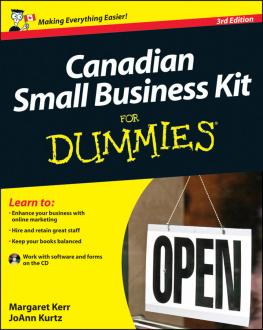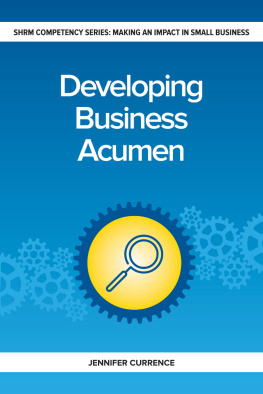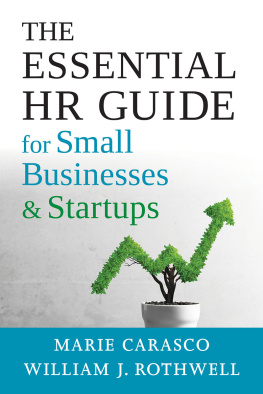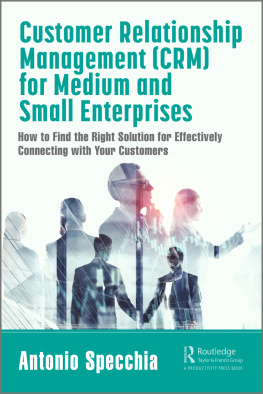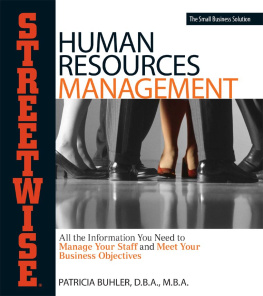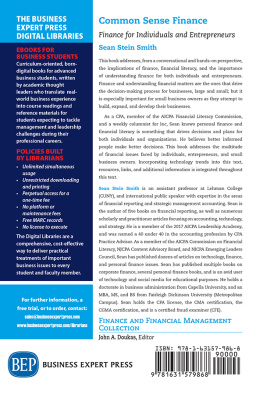HR Guidebook for Small Businesses
Copyright 2015 Elaine Yin-Tantouri
Published by Elaine Yin-Tantouri
Edition License Notes
Thank you for downloading this e-book. Thisbook remains the copyrighted property of the author, and may not beredistributed to others for commercial or non-commercial purposes.If you would like to share this book with another person, pleasepurchase an additional copy for each recipient. Thank you for yoursupport and respecting the hard work of this author.
Table of Contents
About This Book
Thank you for purchasing one of Hi-Life Hubs collection. Hi-LifeHub series aims to improve the performance of individuals andbusinesses. We believe that for any improvement in performance, weneed to look at 3 performance levels individual (job), processand organization; and 3 performance needs goals, design andmanagement. This way, there will be alignment throughout for a moreholistic system.
This is a resource for business owners andline managers who wants to make significant changes to yourbusiness by focusing on what is important - your people and how togo about managing and motivating them. This book is not meant to belong and exhaustive. It aims to get straight to the point and guideyour thoughts and processes.
Introduction
Many small businesses need direction inhuman resources management. Small businesses generally are notlarge enough to hire their own Human Resources Manager, but arestill in need of human resource information and tools. In somecases with smaller companies, this responsibility is the burden ofthe owner, a senior staff member who is not trained in HumanResources (HR) or in a worst case scenario, no one.
With these in mind, this is the mainobjective of this Human Resource Guidebook. This Guidebook is aninformational kit to help small businesses deal with the key humanresources activities. It is also designed to provide these smallbusiness owners and managers with tools and techniques to developtheir HR skills.
This Guidebook will provide an overview andimportance of each of the key HR activity as well as the processesinvolved. It contains components which are aimed at providing bothessential information and additional support for small businesses.Focus will be placed on the following key HR areas:
- Recruitment
- Orientation and Induction
- Performance Appraisal
- Coaching
- Counseling and Discipline
- Termination
Understanding that you may be busy, thisGuidebook is also structured to get to the point and provide youwith quick information as well as templates and forms which you caneasily amend to suit your business needs.
Chapter One
Recruitment
Companies need employees to work to meet itsbusiness objectives. Recruitment is the activity of employing newmembers to fill vacancies or new positions. Recruitment is theprocess of seeking and attracting a pool of qualified applicantsfrom which candidates for job vacancies are selected.
In other words, the function of recruitment is toensure that the company is adequately and effectively staffed atall times. Its purpose is to attract suitable people to apply foremployment vacancies, by making them aware that such vacanciesexist. It involves matching the applicant with the criteria of thejob and eventually making a selection decision.
Some possible reasons why companies need to recruitto fill these vacancies are that:
- People leave their jobs due to personal reasonslike marriage, relocation with family, to look after kids orparents, etc.
- People leave their jobs due to new jobopportunities, retirement or leave their jobs temporarily for longunpaid leave, maternity leave, travel, etc.
- The company has expanded and new positions need tobe created
- The job scope has expanded
It is important for effective recruitment as thebenefits outweigh the drawbacks. Getting the right person for thejob will ensure:
- Lower staff turnover
- Less time spent on training, counseling andcoaching
- Good team fit
- Good company
- No costly time consuming termination issues toaddress with a wrongly recruited candidate
Drawbacks of ineffective recruitment:
- Loss of time
- Added pressure on the team (e.g. increasedworkload)
- Impact of having no one in position for 4-6months
- Stressful for the manager
- Disruption to business
- Loss business opportunities
- Loss of competitive advantage
- Costly to the company (e.g. retraining)
- High turnover loss of other key staff
- Bad public relations and reputation (e.g.customers needs not met at a timely manner)
Overall, it is essential to take specific action toget the right numbers and the appropriate types of employees doingthe right work at the right time. Figure 1 below summaries theareas covered in this chapter.
Figure 1: Recruitment Process
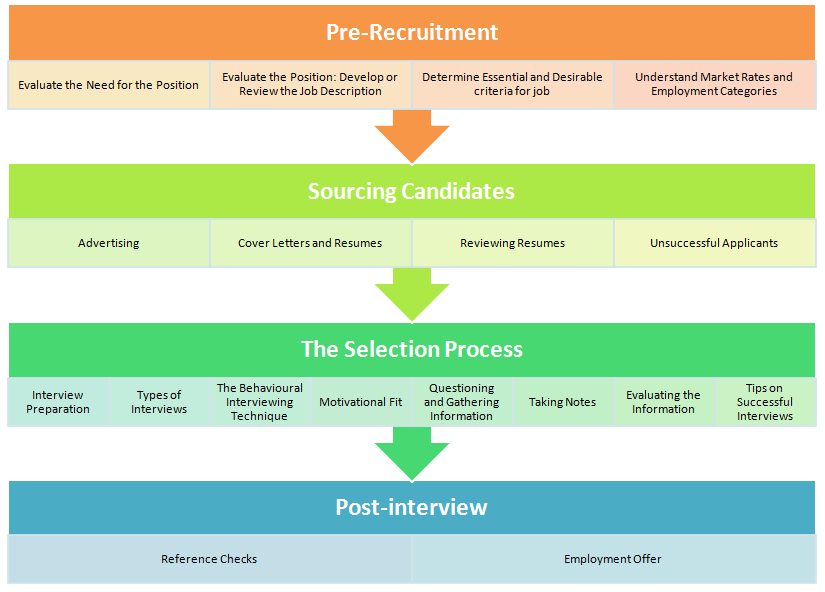
PRE-RECRUITMENT
Evaluate the Need for the Position
Upon the identification of a vacancy eitherthrough staffing changes (e.g. secondment, resignation,termination, retirement, leave) and/or work requirement changes(e.g. creation of a new position, temporary additional workload),there are several points you should consider before recruitmenttakes place:
- What is the purpose of the job? What isdone; how and why is it done?
- Is the job necessary? Does it fulfill itspurposes? Does it need filling at all?
- Does the current workload justifyreplacement or can the work be reallocated to remaining staff?
- Is this workload likely to continue in thelonger term?
- Can the company afford to train a newemployee, for example, if it proves difficult to recruit one whoclosely matches the job specification?
- Is there anybody in the company who isqualified to be promoted to this position?
- Can the job description be amended to makethe job more attractive to a wider range of applicants, forexample, by introducing job rotation, job enlargement or flexibleworking hours?
- Would it be preferable to train anddevelop existing staff?
- Is it preferable to outsource thework?
- Is there an alternative such as overtime,outsourcing or job-sharing?
Evaluate the Position: Review or Develop theJob Description
Once the decision has been taken to fill ajob vacancy, whether internally or externally, it is necessary toevaluate the position:
- Define the roles and responsibilities ofthe position (Specify tasks, responsibilities, skills, knowledgeand qualifications).
- Review the roles and responsibilities forthe replacement position (i.e. the position of the internalemployee who is moving from) to ensure that these have not changed.If these have been changed, revise the job responsibilities asnecessary. For a new position, determine the job requirements andformalize a Job Description accordingly.
Reviewing Job Description
- A very simple way to analyze therequirements of the job is to ask the current person doing the job.Ask them to list their tasks, responsibilities and duties. Comparethese to the job description and add or change specific tasks andresponsibilities as necessary.
- Ask them to list the skills, knowledge andattributes they need to perform the job effectively. This will giveyou a framework for finding the most suitable candidate.
Develop Job Description
A Position or Job Description describes thetasks that are to be undertaken by an individual within thecompany, and can usually be regarded as part of the contract ofemployment since it provides evidence of the duties that theemployee is required to perform. The skills, knowledge andattributes (person specification) listed in the job descriptionwill also provide the company with the key selection criteria forthe position. In other words, the key selection criteria are thosewhich are crucial to the successful conduct of the job. The jobdescription is also a good reference document on which to basequestions and provide information at the job interview. A jobdescription may be given to applicants upon request, and should beprovided as part of the successful applicants inductionpackage.

